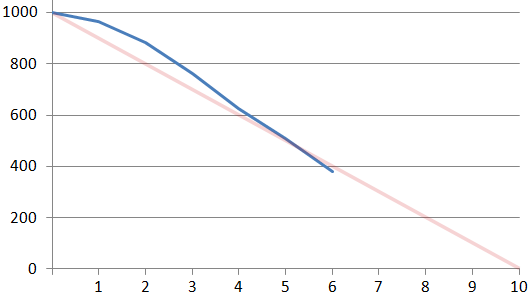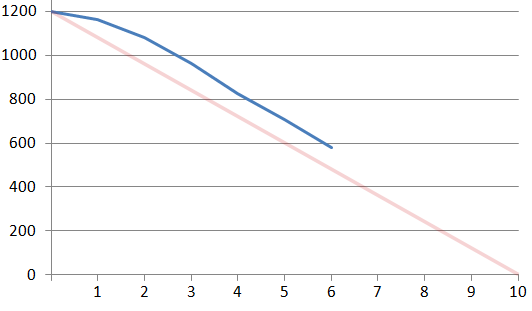A burn down chart is the best way to tell if the team is on track to finish the project on time, or to put it another way, how much functionality will still be in the backlog on go-live date. There is always something left in the backlog.
But what happens when additional tasks and stories come to light that add to the original effort? Or when tasks are re-estimated and the number of Story Points go up? Agile has no problem adding additional tasks to the backlog, but how should this affect the burn down chart?
To illustrate this example, imagine of a project with a total of 1000 story points for completion. By the end of iteration six the burn down chart might look like this, everything tracking well for completion.

During the course of development of iteration six, two hundred new story points of work are identified, either because of new user stories or additional effort on existing stories (okay, two hundred story points is an extreme case on such a small project; additional stories are usually small, comparable in size to other stories, and tend to appear throughout development not all in one iteration, but this is just to illustrate the point). So what do you do with the burn down chart? You could try and keep tracking the original burn down chart with the original tasks and clone a new one that reflects the new effort, but this is unnecessary work.
It is far better to add the additional 200 story points to the original chart total and move the progress line completely.

The adjustment is easily communicated to the business stakeholders. “The total has increased because the integration partner insisted we do all the data cleansing”.
So given the additional stories on the new chart, something clearly has to be descoped or the project won't finish on time.
![]() Tip: The burn down chart should be an accurate representation of the current state of the project, not an idealized view of what everyone thought the project would look like at the beginning. New stories are created all the time on a healthy agile project with a clear vision so it is common to see 100% of additional story points added, especially if the development team is faster than they expected to be.
Tip: The burn down chart should be an accurate representation of the current state of the project, not an idealized view of what everyone thought the project would look like at the beginning. New stories are created all the time on a healthy agile project with a clear vision so it is common to see 100% of additional story points added, especially if the development team is faster than they expected to be.
